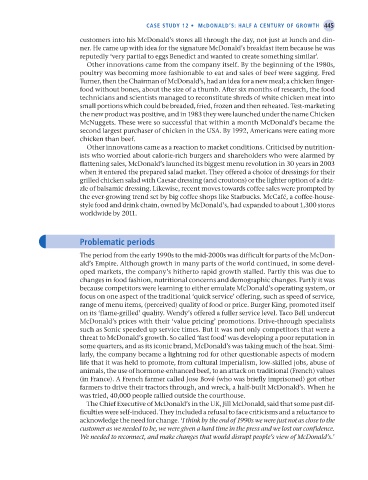Page 470 - Operations Strategy
P. 470
case study 12 • McDONALD’S: hALf A ceNtury Of grOwth 445
customers into his McDonald’s stores all through the day, not just at lunch and din-
ner. He came up with idea for the signature McDonald’s breakfast item because he was
reputedly ‘very partial to eggs Benedict and wanted to create something similar’.
Other innovations came from the company itself. By the beginning of the 1980s,
poultry was becoming more fashionable to eat and sales of beef were sagging. Fred
Turner, then the Chairman of McDonald’s, had an idea for a new meal; a chicken finger-
food without bones, about the size of a thumb. After six months of research, the food
technicians and scientists managed to reconstitute shreds of white chicken meat into
small portions which could be breaded, fried, frozen and then reheated. Test-marketing
the new product was positive, and in 1983 they were launched under the name Chicken
McNuggets. These were so successful that within a month McDonald’s became the
second largest purchaser of chicken in the USA. By 1992, Americans were eating more
chicken than beef.
Other innovations came as a reaction to market conditions. Criticised by nutrition-
ists who worried about calorie-rich burgers and shareholders who were alarmed by
flattening sales, McDonald’s launched its biggest menu revolution in 30 years in 2003
when it entered the prepared salad market. They offered a choice of dressings for their
grilled chicken salad with Caesar dressing (and croutons) or the lighter option of a driz-
zle of balsamic dressing. Likewise, recent moves towards coffee sales were prompted by
the ever-growing trend set by big coffee shops like Starbucks. McCafé, a coffee-house-
style food and drink chain, owned by McDonald’s, had expanded to about 1,300 stores
worldwide by 2011.
Problematic periods
The period from the early 1990s to the mid-2000s was difficult for parts of the McDon-
ald’s Empire. Although growth in many parts of the world continued, in some devel-
oped markets, the company’s hitherto rapid growth stalled. Partly this was due to
changes in food fashion, nutritional concerns and demographic changes. Partly it was
because competitors were learning to either emulate McDonald’s operating system, or
focus on one aspect of the traditional ‘quick service’ offering, such as speed of service,
range of menu items, (perceived) quality of food or price. Burger King, promoted itself
on its ‘flame-grilled’ quality. Wendy’s offered a fuller service level. Taco Bell undercut
McDonald’s prices with their ‘value pricing’ promotions. Drive-through specialists
such as Sonic speeded up service times. But it was not only competitors that were a
threat to McDonald’s growth. So called ‘fast food’ was developing a poor reputation in
some quarters, and as its iconic brand, McDonald’s was taking much of the heat. Simi-
larly, the company became a lightning rod for other questionable aspects of modern
life that it was held to promote, from cultural imperialism, low-skilled jobs, abuse of
animals, the use of hormone-enhanced beef, to an attack on traditional (French) values
(in France). A French farmer called Jose Bové (who was briefly imprisoned) got other
farmers to drive their tractors through, and wreck, a half-built McDonald’s. When he
was tried, 40,000 people rallied outside the courthouse.
The Chief Executive of McDonald’s in the UK, Jill McDonald, said that some past dif-
ficulties were self-induced. They included a refusal to face criticisms and a reluctance to
acknowledge the need for change. ‘I think by the end of 1990s we were just not as close to the
customer as we needed to be, we were given a hard time in the press and we lost our confidence.
We needed to reconnect, and make changes that would disrupt people’s view of McDonald’s.’
Z12 Operations Strategy 62492.indd 445 02/03/2017 13:56

